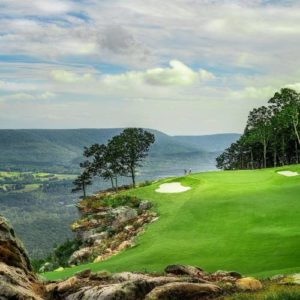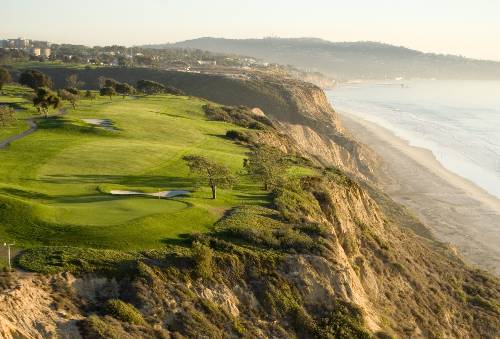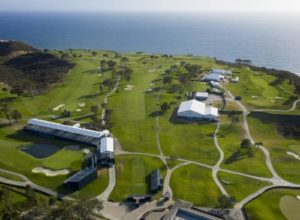
LA JOLLA, CA –
Just like his father before him, they called him the Open Doctor, and he took up his father’s mantle and carried it with the same success and grace. Rees Jones has been prepping major championship venues for decades all across America. Now we return to one of his most celebrated success stories, Torrey Pines South Course, site of a regular Tour stop every year, but also host of one unforgettable U.S. Open.
We caught up with Rees as he was making his way to San Diego for the week as his redesign of the South Course now hosts its second National Championship.
JF: Tell us about the first time you saw Torrey Pines. How huge a project was it getting it ready for the Open?
RJ: I hadn’t seen the South Course until I came out in 1999. I had seen it on TV, so I was familiar with the layout. A group called the Friends of Torrey invited me out and asked me if I thought that the South Course might be another public course strong enough to host a U.S. Open. That was their dream: to host the U.S. Open. They saw Bethpage had been selected and was being prepared for 2002, and they thought they could recreate it on the west coast. So in a way, it was the success of Bethpage Black in obtaining a U.S. Open that led to Torrey getting one as well. But to get Torrey ready, we had to rebuild the entire golf course and redesign the entire golf course.
JF: What parts did you completely redesign and what did you keep?
RJ: We utilized the essence of the Billy Bell routing, which is my philosophy when it comes to someone else’s work: use what was there, don’t completely blow it up.
But the South course wasn’t a truly U.S. Open championship course – it was too easy. We utilized the canyons for strategies, and brought the greens closer to the natural hazards, including the ocean on number four. And then we redesigned the greens into old-fashioned, classic greens running from back to front.
You see back when my Dad did Open courses, the front hole location was the hard location. But then when pros started spinning the ball more, the back hole locations became the more difficult ones to access…partly because the modern pro can drop it on a dime, they don’t release the ball as much nowadays.
That’s why Torrey is such a great course for today’s play and equipment; they have to hit a precise shot that stops. If you go over the green it’s really hard to recover and make par.
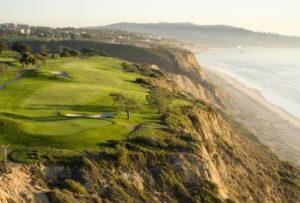
JF: My bird dogs out on the course showed me video of balls completely vanishing in the rough…
RJ: These guys are strong enough to get out of it in today’s game. They proved that at Winged Foot.
JF: And Bethpage Black. Speaking of which, how was the project similar to Bethpage Black? How was it different? Was it a tougher job than the Black Course or easier?
RJ: I think we spent the same amount of money: Â 3 – 3.5 million on each one.
The Black was a restoration, and it had never been changed from when A.W. Tillinghast designed it. We brought back all the Tillie that was there, with mere improvements for today’s game such as length and bunker positioning off the tee and around the greens.
JF: Yes, and you also did those interesting looking inkblot bunkers, that were more aesthetically pleasing than the former simple circles.
RJ: Â The Black was Tillinghast’s public Pine Valley – he had enormous bunkers there too. Over the years those bunkers got edged, and they were horribly maintained, so we tried to bring back a sculptured Tillinghast style – something you’d see at Ridgewood, for example, in New Jersey. Windswept bunkers, as I call them.
Now at Torrey we had to start over from almost scratch – we rebuilt every green, moved some greens closer to hazards, basically re-bunkered all the fairways, and added 500 yards in length. These greens now have more contour than Bethpage. Bethpage Black has subtleties, Torrey’s contours are dramatic.
JF: Give us some specific examples on the course.
RJ: 11, 12, 14, and 16. And there are also places to hide pins in the back, little tongues. At Torrey we protect the hole locations with dramatic green contours and approach angles, while at Bethpage the hole locations are protected by massive bunkers and rough in front of the green. Also, Torrey has more open entrances to the greens to accept a running shot, while the Black has more heavily protected greens in the front.

JF: What was the most difficult part of the renovation?
RJ: 9/11 hit and we couldn’t transport anything across state lines for a whole month. We lost a month in construction before the Buick Invitational that year.
JF: What would you say are the hallmarks of a Rees Jones designed golf course, and where on Torrey’s South course might golf fans see some of those features?
RJ: I hope there aren’t any! Basically, you design the golf course on the criteria of its purpose and the natural features of the site. So to some degree in my major championship course re-dos, the addition of the contours work to help defend par. You have smaller greens within larger greens.
JF: I noticed that at Torrey, particularly at the par-5s.
RJ: Yes. It rewards the guys that attack the hole and succeed. And if they fail and miss or bail out, they have a tough two putt for par.
JF: How often have you been back, and in what way will this year’s Torrey differ from the ’08 Torrey?
RJ: I’ve been back quite a bit. I’ve gone to the Farmers Open a few times, and then we came back again in 2019. The city revisits all their golf facilities every 15 years, so we put in new irrigation and new grasses – Latitude 36 on the approaches to the greens, while the green surfaces are a bent and poa mix – and we did the collars so that an approach out of the rough will release on to the surface. We also lowered the height of the bunker edges that had been built up with sand, returning them to their original height. We added 100 yards total at 10 and 15, and they are now more demanding. We got rid of short bunkers and relocated then farther out from the tees to accommodate today’s championship play.
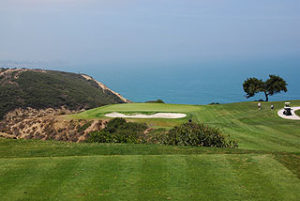
JF: What are the swing holes at Torrey? Where will we see the widest range of scores?
RJ: They’ve got to make hay on the front nine. After the first, a long, tough par-4 that doglegs, but it’s a tough tight shot, they get a let up on the next few until they hit number six, which is a par-5 converted to a long par-4 for the championship. From here on it’s a long stretch until they reach the course’s Amen Corner: 11-12-13.
11 is a long par-3, into the prevailing wind. 225. Then 12 is over 500 yards, but a par-4, also into wind and well bunkered. It’s a tough green to access.
JF: And then 13 the par-5 Phil Mickelson made into a taco salad Saturday in 2008, taking four tries to get up the false front.
(Laughter)
RJ: Yes. He made a nine on it. They’ll want to hit a long tee shot there, because they’ll want to get home in two. They do not want to have to hit from that valley. You can’t see the bottom of the flag; it’s such an elevated pitch, so you can’t visualize it as easily.
So really only two, three, and four are the holes where they can really put the gas pedal down. For the most part, you have to make your run early, but you do get two last shots at the end. 17 is birdie-able and 18 is a birdie or eagle opportunity. That’s what makes it such a great championship venue. At the end you can really make up ground.
JF: What do you think will be the winning score?
RJ: It depends on conditions. But the way John Bodenhamer set it up I think it’ll be 5 or 6-under. It won’t be 1-under like last time.
JF: If you could pick a course to host its first U.S. Open, a course that has never hosted a major before, what would it be?
RJ: Well never mind “not hosting one before,” I think Bellerive should host a major championship every ten years. They have the greatest sports town in America out there.
Bellerive is ideal for player satisfaction; they loved it. And the fans in 2018 were so supportive of everyone out there. They really loved the golf. Plus you have the Cardinals in their “Sea of Red,” and all the sports history of all their teams. But best of the folks there are all quality people.
And then I think Hazeltine should have another U.S. Open. It’s always been a major success. The cream does rise to the top at Hazeltine.
JF: What next for you? What are you working on now?
RJ: I have new 18 I’m planning at a place called McLemore, near Chattenooga, but nestled in the mountains of Georgia. It’s a piece of ground that could host a major. It’s on Lookout Mountain. And we also just redid another at 18 McLemore. Golf Digest recently said that 18th is the best finishing hole designed in the last 20 years.
